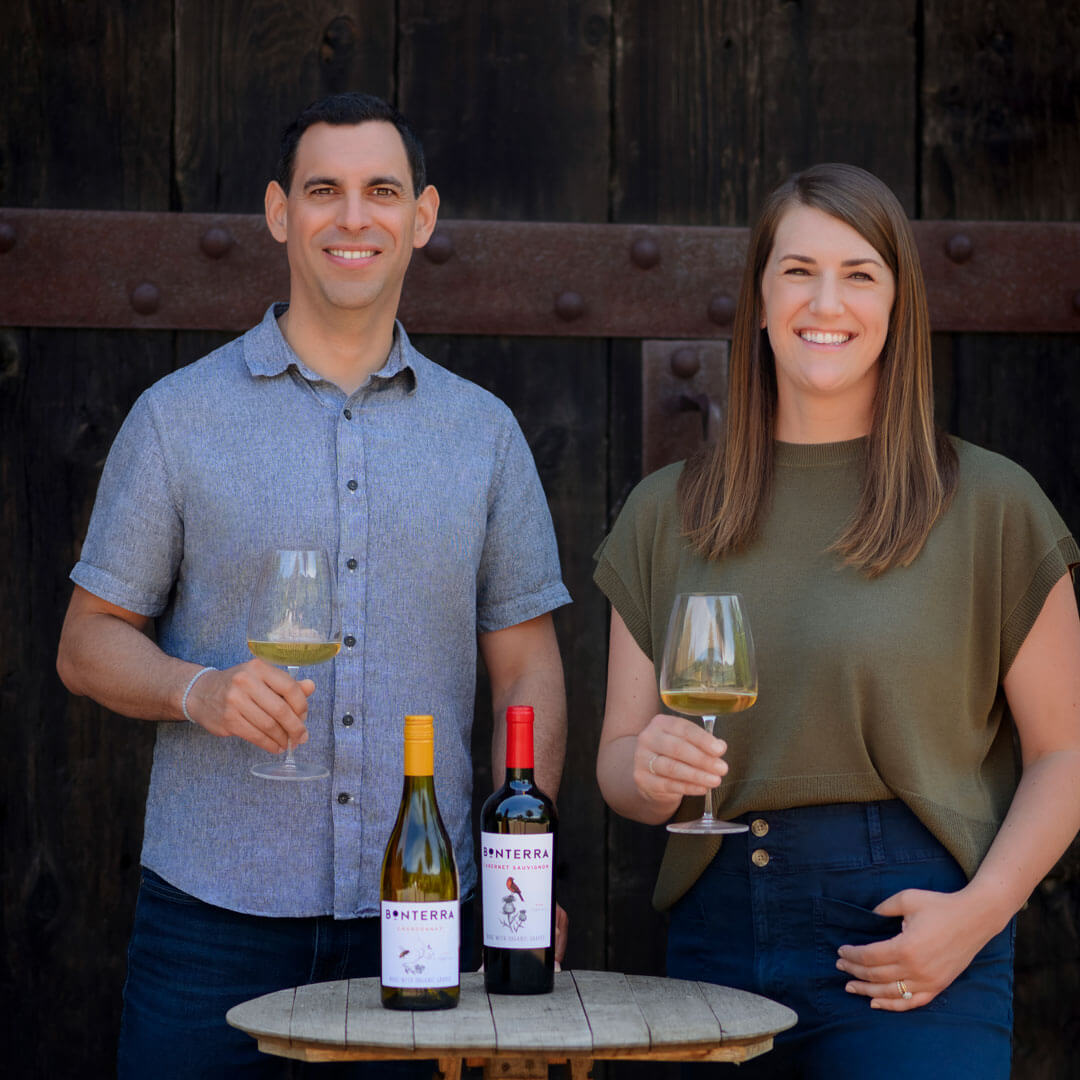Zesty, mouthwatering, crisp, refreshing – when we talk about wine like this, we’re really talking about acidity. But is wine acidic? Like other fruits, wine grapes naturally contain a variety of chemical compounds classified as acids in their pulp. The type and amount of these acids play important roles in how well a wine ages, how we experience a wine’s taste, and – maybe most importantly – how a wine interacts with food.
In this post, we’ll explore how acidity affects the flavors we perceive in a wine, and how to use that knowledge to create more delicious food and wine pairings.
What is Acidity in Wine?
Acidity is essential to creating a wine that is resistant to spoilage, that tastes fresh and energetic, and that pairs well with a variety of foods. Wine grapes naturally contain several different types of acids, including malic acid, tartaric acid (also known as cream of tartar), and a little bit of citric acid. Unripe grapes have a lot of these acids, which is why they taste tart and sour, but as the clusters ripen and sugar levels go up, the acid levels go down. The winemaker aims to harvest when the balance of sugar and acidity is optimal for the style they want to achieve. With sparkling wines like Champagne, for example, wineries deliberately pick the grapes early to retain high acidity.
Because there is less heat and sunlight to ripen the fruit, cooler growing regions naturally tend to produce grape varieties with less sugar and more acidity than warmer regions. In sunnier regions, the grapes typically accumulate plenty of sugar (which creates richer textures and higher alcohol), but lose most of their acidity in the process. To correct this, winemakers in warmer climates will commonly adjust acidity in the cellar by adding a bit of acid back in.
In colder growing climates, winemakers may need to take steps to neutralize excessive acid in the wine, or transform it into a less sharp form. Certain yeasts can convert malic acid in wine to lactic acid in the cellar, through a chemical reaction referred to variously as malolactic conversion, malolactic fermentation, or secondary fermentation. Wines that have gone through malolactic conversion have a smoother, richer texture and a less pronounced acidity than wines that have not. Since this process also tends to mute fruity and floral notes, though, malolactic conversion is usually avoided with aromatic wine grapes like Sauvignon Blanc or Riesling, whose aromatic zestiness is a key part of their appeal.
The winemaker’s goal in the cellar is always to strike a delicious balance between acidity and the other components of the wine. That balance is subjective, which is why different winemakers can make very different wines from the same exact wine grapes.
How Acidity Affects Wine Flavor
Acidity level plays a huge role in how we taste and experience wine. A higher-acid wine will taste more vibrant and crisp, while a lowacid wine might taste richer and more mellow. Wines with too little acid will seem flat, flabby and dull, while wines with too much acidity come across as sharp, biting and sour.
Acidity itself has different flavors, based on what kind of acidic compound is in the wine. A high-acid wine that has not gone through a secondary fermentation will often have a vibrant freshness that reminds you of green apple – thanks to the malic acid from the grapes. (The name “malic” actually traces back to the Latin word for apple, malum.) Wines that have undergone malolactic fermentation will have swapped their malic acid for lactic acid, which tastes softer, and more like yogurt or sour cream. (“Lactic” we also get from Latin, with lac meaning milk.)
Acidity level also affects our perception of basic tastes – most notably, sweetness and bitterness. In both cases, acidity decreases our sensitivity to these flavors. Very sweet dessert wines with very high acid will seem less sweet than lowacid wines with the same sugar content. Bitter foods, like broccoli rabe or radicchio, will taste less bitter if paired with an acidic wine. (But don’t pick a wine with a lot of bitterness of its own, since this will only magnify the bitterness.)
The Role of Acidity in Food Pairing
Acidity stimulates our salivary glands and our appetites by literally making our mouths water. That mouthwatering power is fantastic for cleansing our palates before a meal, between courses, and between bites. Acidity helps to dissolve and break down fats, making heavy dishes seem lighter and more balanced. Fatty, rich, or oily foods can often be set off beautifully by a high acidity wine that can cut through the richness, and refresh your palate with every sip.
A zesty Sauvignon Blanc, for example, makes a classic (and great!) wine pairing with goat cheese, but also a surprisingly delicious refreshing match with an herb-flecked Italian sausage, grilled pork banh mi, or tacos al pastor. The wine’s bright, even tart acidity helps lift the dishes’ richness, and create a tasting experience greater than the sum of its parts.
A fresh Pinot Noir – typically one of the highest acid red wines, along with Sangiovese – is a lovely match with creamy mushroom sauces, braised lamb shanks, and fatty fish for the same reason. The freshness in the wine keeps the food feeling balanced and exciting, bite after bite.
High-contrast pairings are not the only path to greatness, though. Many successful pairings are more like mirroring, where the acidity in the food and the acidity in the wine are similar. The rule of thumb with all food pairings, however, is to choose a wine with at least as much acidity as the food. If your food is more acidic than your wine, the wine will taste flat and lifeless.
This is why we tend to say that higher-acid wines are more food-friendly. Because so many of our favorite foods and dishes have a fair amount of acidity, wines with a healthy dose of acid tend to offer a lot more options than low-acid wines.
Tips for Choosing and Serving High-Acid Wines
Unfortunately, acidity is not something that shows up on most wine labels or mainstream tasting notes. If you’re searching for a high-acid wine, look for words like “zesty,” “crisp,” “nervy,” and “racy” in the description, and try to choose wines from producers you know craft their wines in that style. While it’s usually true that the colder the growing region, the more acidic the wine will be, winemaking styles and techniques do vary a lot, and there are many delicious higher-acid wines made with grapes grown in warmer regions. (Bonterra makes a great one for under $15 – and it’s farmed at our organic winery!)
Whichever high acidity wine you choose, be sure to chill it down a little before serving. Cooler temperatures help highlight the acidity on our palates, making it taste fresher and lighter. The ideal temperature for serving crisp white wines is 45-50 degrees Fahrenheit; light, fresh red wines like Pinot Noir are best around 55.
Sauvignon Blanc and Pinot Noir are typically great examples of higher-acid wines, capable of pairing well with an unbelievable range of different dishes. But don’t be afraid to explore varieties further afield, from Gamay, Sangiovese and Nebbiolo (higher acid reds) to Chenin Blanc, Riesling, Alvarinho/Albariño, and Verdejo (higher acid whites). Variety – plus a bit of balanced acidity – is the spice of life!
Embracing Acidity in Wine
While the idea of acid in your wine might sound scary, the truth is that we need it there! To stimulate the appetite, refresh our palates, and complete the perfect bite, acidity is really the best.
Bonterra offers a selection of wines that can’t be beat. Bonterra wine is crafted with organically farmed grapes, ensuring we keep everything good in the bottle. You can buy our wine online, or sign up for the wine club to get access to exclusive releases. Let us guide you on your journey as a wine lover!




